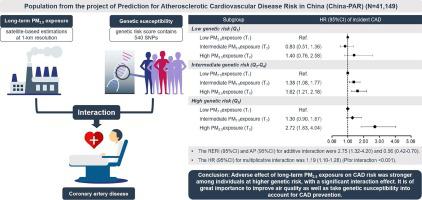Environment International ( IF 10.3 ) Pub Date : 2022-11-10 , DOI: 10.1016/j.envint.2022.107624 Jinyue Li 1 , Fengchao Liang 2 , Fangchao Liu 1 , Jianxin Li 1 , Keyong Huang 1 , Xueli Yang 3 , Shufeng Chen 1 , Jie Cao 1 , Chong Shen 4 , Liancheng Zhao 1 , Ying Li 1 , Dongsheng Hu 5 , Wending Wang 6 , Jianbin Wu 7 , Jianfeng Huang 1 , Xiangfeng Lu 1 , Dongfeng Gu 8

|
Background
Although both environmental and genetic factors were linked to coronary artery disease (CAD), the extent to which the association of air pollution exposure with CAD can be influenced by genetic risk was not well understood.
Methods
A total of 41,149 participants recruited from the project of Prediction for Atherosclerotic Cardiovascular Disease Risk in China (China-PAR) were included. Genetic risk scores of CAD were constructed based on 540 genetic variants. Long-term PM2.5 exposures were assessed by adopting satellite-based PM2.5 estimations at 1-km resolution. We used stratified Cox proportional hazards regression model to examine the impact of PM2.5 exposure and genetic risk on CAD risk, and further analyzed modification effect of genetic predisposition on association between PM2.5 exposure and CAD risk.
Results
During a median of 13.01 years of follow-up, 1,373 incident CAD events were observed. Long-term PM2.5 exposure significantly increased CAD risk, and the hazard ratios (HRs) [95% confidence intervals (CIs)] were 1.27 (1.05–1.54) and 1.95 (1.57–2.42) among intermediate and high PM2.5 exposure groups compared to low PM2.5 exposure group. The relative risks of CAD were 40% (HR: 1.40, 95%CI: 1.18–1.66) and 133% (HR: 2.33, 95%CI: 1.94–2.79) higher among individuals at intermediate and high genetic risk than those at low genetic risk. Compared with individuals with both low genetic risk and low PM2.5 exposure, those with high genetic risk and high PM2.5 exposure had highest CAD risk, with HR of 4.37 (95%CI: 3.13–6.11). We observed significant multiplicative (P < 0.001) and additive interaction [relative excess risk due to interaction (95%CI): 2.75 (1.32–4.20); attributable proportion due to interaction (95%CI): 0.56 (0.42–0.70)] between genetic risk and PM2.5 exposure on CAD.
Conclusion
This study provided evidence that long-term PM2.5 exposure might increase CAD risk, especially among people at high genetic risk. Our findings highlighted the importance of taking strategies on air quality improvement to cardiovascular disease prevention.











































 京公网安备 11010802027423号
京公网安备 11010802027423号